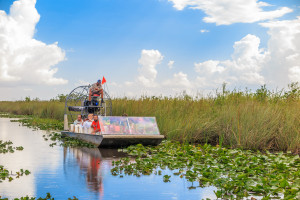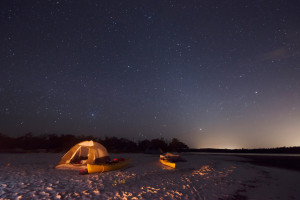 What’s the best way to see the Everglades? There are several options, and each offers a very different experience. Foot soldiers will enjoy the intricate trail systems spread across the Everglades ecosystem. And for water lovers, the adventures are endless. For a workout, pursue a paddle trail. Or for a more relaxed experience, hop on an airboat. Here’s the low down on each Everglades recreational activity.
What’s the best way to see the Everglades? There are several options, and each offers a very different experience. Foot soldiers will enjoy the intricate trail systems spread across the Everglades ecosystem. And for water lovers, the adventures are endless. For a workout, pursue a paddle trail. Or for a more relaxed experience, hop on an airboat. Here’s the low down on each Everglades recreational activity.
Hikes
If you don’t want to get in the water with the gators, stick to the sidelines. Hiking is a peaceful, slow-pace way to explore the inner workings of the Everglades. Trekking through the wilderness gives you an opportunity to see Florida flora up close and personal. Here are few favored trails and what you might see should you choose to embark on them:
- Anhinga – This is one of the most hiked trails in Everglades National Park due to its close proximity to the entrance and its short distance. Less than a mile long, the hike showcases lots of Everglades wildlife, including the “King of the Everglades,” otherwise known as the American alligator. The Anhinga Trail is rated easy for all ages.
- Bayshore Loop – At 1.3 miles, this scenic hike winds along the Florida Bay, exposing gorgeous panoramic views. Rated easy to moderate, the trail suits most hikers. Be sure to stop and admire the many shorebirds that come to feast during low tide.
- Old Ingraham Highway – The seasoned hiker will relish this moderate to extreme 22-mile trail. Originally used as a highway circa 1922, the crumbling road now serves hikers and backpackers alike. This is not only one of the longest trails in Everglades National Park, but it is also one of the only to host backcountry campsites.
- Otter Cave Hammock – For a short but rewarding hike, opt for the Otter Cave Trail. Only a mile long, the trail promises scenic pools, glimpses at solution holes and opportunities to see wildlife. This trail is often flooded, so be sure to assess the conditions because setting out.
Paddle Trips
Backcountry campers will love the wide variety of campsites sprinkled about Everglades water trails. Take your kayak, canoe or paddleboard and set off on an adventure like none other. Trails vary from day trips to multi-day endeavors, and you’re guaranteed to see remote areas of the Everglades no matter what. Some sought-after Everglades water trails include:
- Nine Mile Pond
- Hell’s Bay
- Turner River
Airboat Tours
Perhaps the most popular way to see the Everglades is by airboat. While all other Everglades modes of exploration require physical exertion, airboat rides allow you to sit back and enjoy the scenery. This family fun option exposes passengers to a wealth of wilderness. Though it’s not guaranteed, plenty of folks leave their airboat tour having seen a gator or two (from a safe distance of course). Airboats successfully jet through the shallow areas of the Everglades due to their airplane-like propellers. Any ordinary boat could not cruise through the marsh like an airboat can, making it a truly unique experience. To schedule your private airboat ride, call Captain Mitch’s Everglades Airboat Tours at 239-695-3377.
 You’ve probably heard about most Everglades predators: large alligators, monstrous pythons, elusive black panthers, and the list goes on. But do you know about the smelliest, most reclusive predator of them all? It’s called the Everglades skunk ape, rightfully named for its supposed rotten eggs stench. It walks on two legs, its whole body immersed in dark brown fur, and it stands at a baffling seven feet tall. Of course, all of this information relies on hearsay, but some Florida folks swear they’ve seen the tall, foul-smelling swamp monster.
You’ve probably heard about most Everglades predators: large alligators, monstrous pythons, elusive black panthers, and the list goes on. But do you know about the smelliest, most reclusive predator of them all? It’s called the Everglades skunk ape, rightfully named for its supposed rotten eggs stench. It walks on two legs, its whole body immersed in dark brown fur, and it stands at a baffling seven feet tall. Of course, all of this information relies on hearsay, but some Florida folks swear they’ve seen the tall, foul-smelling swamp monster.
 Are you planning a vacation to the Everglades, but you don’t want to break the bank? Camping is a fantastic alternative to staying in a hotel, especially when it comes to experiencing the vast wilderness of the Everglades.
Are you planning a vacation to the Everglades, but you don’t want to break the bank? Camping is a fantastic alternative to staying in a hotel, especially when it comes to experiencing the vast wilderness of the Everglades.





